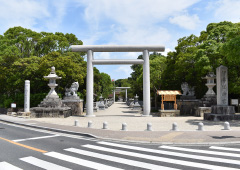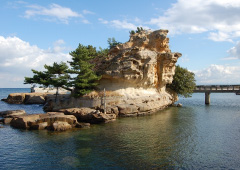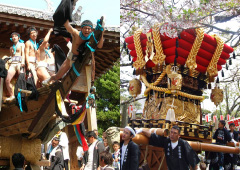Awaji Island Kuniumi Association
- Top
- History & Culture
History & Culture
Kuniumi shinwa -Japan's very own creation myth-
This is a story from time out of mind, a time when the world was without form.
It is the Kuniumi Shinwa, as Japan's very own creation myth is known.
Izanagi-no-mikoto and Izanami-no-mikoto, two divine beings, male and female respectively, were sent down from Heaven to create and populate the lands that mortals would live in. First, they churned the ocean with a "heavenly spear" to generate form out of the formless void.
This action, so the story goes, caused drops of salt water to fall from the spear-tip, and these drops formed the first island, named Onogoro Island.
The divine couple descended from Heaven to this island, and performed the ritual of Kuniumi, or "creation of the land," agreeing to take mortal form and live as a man and his wife.
They went on to create a series of islands, and the resulting archipelago was "Oyashima no Kuni": Japan.
According to the "Kojiki" and the "Nihon Shoki", the two 8th-century historical works through which this myth has been passed down to posterity, the first island to be created in this session was "Awaji no Honosawake no Shima," or in other words, Awaji-Island.
Awaji-Island was the first island to be created. Home to numerous places associated with Japan's creation myth, it lures visitors with its enigmatic hints of storied antiquity.
Izanagi-Jingu Shrine is Japan's oldest shrine, said to be built on the site of the dwelling at which the divine creators Izanagi lived out their last days as mortals, having fulfilled their mission of creating the world.
Echoes of ancient myth can also be found in locations dotted about all over Awaji, including Onokorojima Jinja Shrine -- identified by some as the site of the mythical Onokoro Island -- as well as Eshima and Nushima islands.
Related information
Izanagi-Jingu Shrine
The deities enshrined here are Izanagi-no-mikoto and Izanami-no-mikoto, who performed all the divine actions resulting in the birth of Japan. The ancient Awaji Kagura (Shinto music and dance), with its distinctive beat, can be heard at this shrine to this very day.
Onokorojima Jinja Shrine
Set in one of the locations held by some to be the "Onokoro Island" featured in the creation myth, this shrine protects the whole of Awaji Island with its monumental torii gate. Reputed to be efficacious in matchmaking, it also attracts numerous visitors from off the island.
Eshima Island
The numinous island of Eshima is another contender for the true identity of the mythical "Onokoro Island." A long-established and widely loved tourist spot. At night it appears to float eerily on the water, an island aglow.
Nushima Island
With its natural shape still unchanged to this very day, the island attracts many visitors as an unspoiled island park. It is also a contender for the status of the actual location of the mythical Onokoro Island.
Awaji Ningyo Joruri -A traditional pupperty performance-
Awaji Ningyo Joruri, the island's traditional performing art, can trace its history back some 500 years.
A genre of performing art unique to Japan, Ningyo Joruri features a musical accompaniment played on the Shamisen (a three-stringed instrument resembling a lute). The play is accompanied by a narrative charged with emotional drama, narrated by chanters known as "Tayu", played out through puppets that appear to possess an uncanny capacity for emotional expression.
The Edo period (1603 to 1868) saw the birth of masterpieces such as Sonezaki Shinju ("Love Suicide at Sonezaki") and Kokusen'ya Kassen ("The Battles of Coxinga") by Chikamatsu Monzaemon, which enjoyed great popular success and were eventually celebrated as classics of their time.
In recent years, Awaji-Ningyo Joruri has been designated an Important National Cultural Property. The art form is being actively cultivated and performed overseas to promote traditional Japanese culture. These overseas performances are highly popular. The Japan Society for the Preservation of Ningyo Joruri holds a national puppetry performance summit on Awaji Island as part of these cultural activities.
Matsuri -Festivals-
On Awaji Island, the backdrop to Japan's kuniumi creation myth, festivals are an exciting part of community life.
Saturated with local color, festivals held around the island reflect the down-to-earth spirituality of the islanders, passed down the generations in an unbroken chain to the present day.
Some of Awaji's festivals were created in response to epidemics, droughts and other uncontrollable events in people's lives. These offer insight into the spirituality of the inhabitants' forbears, who sublimated their emotions into a cultural asset.
Dramatized by these festivals is the heroic struggle played out between humanity and the forces of nature.
Amidst the great visual interest of a festival, the danjiri "danjiri=a float for festivals" provide a particular focus of attention. These "god-thrones" are paraded around during a shrine festival.
The typical Awaji version is a Futon-danjiri ("matress-danjiri") consisting of a stack of five flat red cushions, opulently decorated and embroidered. During the spring and autumn festivals, highly ornate futon-danjiri are paraded in locations all over the island.
There are also other highly distinctive versions, such as the Tsukai-danjiri ("manhandling-danjiri"), which is pulled this way and that and repeatedly upended, while carried on the bearers' shoulders, not to mention the Nage-danjiri ("throwing-danjiri") of Ueda Hachiman-Jinja Shrine, and the Funa-danjiri ("boat-danjiri") of Torikai Hachiman-Jinja Shrine. The pride of individual communities, these danjiri are leading tangible cultural properties of Awaji Island.
Besides entertaining the crowds with spectacular festival floats known as danjiri, the islanders take great pride in their danjiri-uta or "float songs."
A kind of ensemble performance or folk-opera performed by local residents, danjiri-uta, in keeping with their other name, joruri-kuzushi ("bits of joruri"), feature highlights from the Ningyo Joruri puppet plays, skillfully excerpted and arranged to a musical accompaniment.
Delivered with tremendous brio, danjiri-uta, cultivated in the soil of the Awaji Ningyo Joruri tradition, are songs that express the islanders' pure feelings for their home.
On festival days, all the local participants proudly shoulder their danjiri and perform their local danjiri-uta with gusto.
















